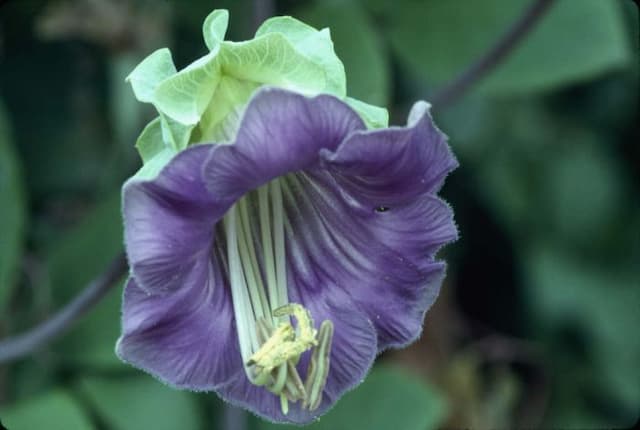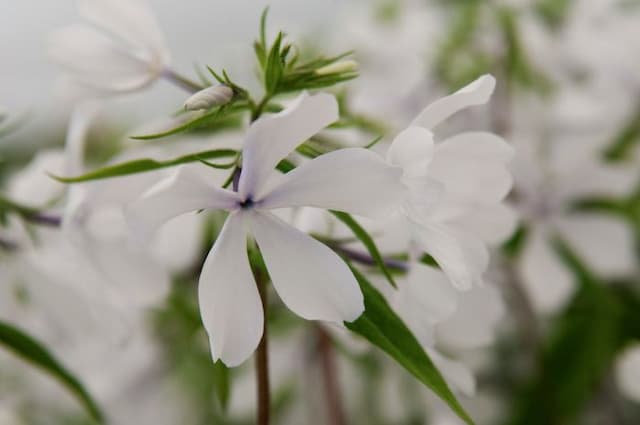Garden Phlox Phlox paniculata 'Chintz'

ABOUT
The Phlox paniculata 'Chintz' is a perennial plant known for its attractive and fragrant flowers. It carries clusters of blooms that are soft pink in color with a lighter, almost white eye at the center, giving it a chintzy appearance that likely influenced its cultivar name. The petals are rounded with a slightly overlapped arrangement, creating dense flower heads that provide a showy display during the blooming season. The plant has lance-shaped leaves that are a rich green, adding a lush backdrop to the delicate blossoms. Its foliage is arranged oppositely on erect, robust stems that host the flowering tops. The appearance of 'Chintz' makes it a favorite in garden borders and as cut flowers because of its appealing coloration and delightful scent.
About this plant
 Names
NamesFamily
Polemoniaceae.
Synonyms
Garden Phlox, Summer Phlox, Perennial Phlox, Fall Phlox.
Common names
Phlox paniculata.
 Toxicity
ToxicityTo humans
Garden Phlox is not known to be toxic to humans. In general, it is considered a safe plant around adults, children, and in gardens. However, as with any plant, individual allergic reactions or sensitivities can occur, so it is always advisable to handle plants with basic precautions, such as washing hands after gardening. If someone were to ingest Garden Phlox and experience symptoms, it's crucial to seek medical advice, but such instances are rare and not commonly reported in relation to this plant.
To pets
Garden Phlox is also not known to be toxic to pets such as dogs and cats. This plant is generally considered safe and is not listed as toxic by major pet poison resources. Of course, pets sometimes have unexpected reactions to plants or might experience gastrointestinal upset if they consume a large amount of any non-food plant material. If any signs of illness are observed after a pet ingests Garden Phlox, it is important to contact a veterinarian. However, toxicity symptoms specific to this plant are not typically expected.
 Characteristics
CharacteristicsLife cycle
Perennials
Foliage type
Deciduous
Color of leaves
Green
Flower color
Pink
Height
2-4 feet (60-120 cm)
Spread
2-3 feet (60-90 cm)
Plant type
Herb
Hardiness zones
4
Native area
North America
Benefits
 General Benefits
General Benefits- Aesthetic Appeal: Phlox paniculata 'Chintz', commonly known as Garden Phlox, adds visual interest to gardens with its soft pink flower clusters.
- Attracts Pollinators: The bright blossoms attract butterflies and hummingbirds, which help pollinate the garden.
- Fragrance: Garden Phlox emits a sweet fragrance that can create a pleasant sensory experience in your landscape or garden.
- Versatility: It can be used in borders, garden beds, and as a backdrop for shorter plants, making it a versatile choice for garden design.
- Extended Blooming Period: Phlox paniculata 'Chintz' blooms from mid to late summer, providing long-lasting color.
- Easy to Grow: It's relatively easy to cultivate and doesn't require specialized care or conditions.
- Perennial Growth: As a perennial plant, it returns each year with renewed growth, saving time and money on replanting.
- Drought Tolerance: Once established, it shows a reasonable level of drought tolerance, reducing the need for frequent watering.
 Medical Properties
Medical PropertiesThis plant is not used for medical purposes.
 Air-purifying Qualities
Air-purifying QualitiesThis plant is not specifically known for air purifying qualities.
 Other Uses
Other Uses- Garden borders: Phlox can be used to create a colorful, low-maintenance border around garden beds or walkways.
- Butterfly gardens: Due to its attractiveness to butterflies, phlox is an excellent choice for butterfly garden designs.
- Cut flower arrangements: The long-lasting blooms of phlox make them ideal for inclusion in fresh flower bouquets and arrangements.
- Natural dye: Historically, some species of phlox have been used to produce natural dyes for fabrics.
- Living mulch: Phlox can act as a living mulch, covering the ground and helping to retain soil moisture and suppress weeds.
- Photography: Phlox's vibrant flowers are a popular subject for garden photography and can be used to enhance the aesthetic appeal of photo shoots.
- Pressed flower crafts: The blossoms of phlox can be pressed and used in crafting projects, such as creating bookmarks or decorating homemade cards.
- Seasonal celebrations: In some cultures, phlox is used as a decorative plant during certain festivals and ceremonies due to its bright and cheerful flowers.
- Educational tool: Phlox can be used in schools to teach children about plant growth, pollination, and the life cycle of insects that rely on them.
- Companion planting: Phlox can be planted alongside vegetables and other garden plants to attract pollinators, thus enhancing pollination and increasing yields.
Interesting Facts
 Feng Shui
Feng ShuiThe Garden Phlox is not used in Feng Shui practice.
 Zodiac Sign Compitability
Zodiac Sign CompitabilityThe Garden Phlox is not used in astrology practice.
 Plant Symbolism
Plant Symbolism- Harmony: Phlox paniculata 'Chintz', commonly known as Garden Phlox, is often associated with harmony as it brings various pollinators together and thrives in diverse environments.
- Unity: The dense clusters of flowers symbolize the unity of individuals in a group, reminiscent of a community or family standing strong together.
- Agreement: The name "chintz" refers to a printed multicolored cotton fabric, which can symbolize the idea of agreement or coming to a common understanding, much like the various colors blend together in fabric prints.
- New Beginnings: As Garden Phlox is a perennial, it represents renewal and new beginnings when it blooms every spring.
- Sweet Dreams: With its pleasant fragrance, Phlox is often associated with sweet dreams and comfort.
 Water
WaterGarden Phlox requires regular watering to maintain consistent soil moisture, particularly during dry periods. It's best to water deeply and thoroughly, providing about one inch of water per week. The actual frequency will depend on your climate and soil type, but watering once or twice a week should suffice. Water the base of the plant to keep the foliage dry and reduce the risk of fungal diseases. During hot summers or in particularly dry climates, you may need to increase the frequency but always check the soil moisture before watering again.
 Light
LightGarden Phlox thrives in full sun, meaning it requires at least six hours of direct sunlight each day for optimal growth and flowering. The best spot for Garden Phlox would be an area that is exposed to the morning sun and has some protection from the intense afternoon heat, although it can tolerate full sun throughout the day.
 Temperature
TemperatureGarden Phlox is hardy and can tolerate a wide range of temperatures, but it grows best when daytime temperatures are between 60°F and 75°F. They can survive temperatures down to about -30°F, making them suitable for growing in USDA hardiness zones 4 through 8. They should be protected from extreme heat, as temperatures consistently above 85°F can stress the plant.
 Pruning
PruningGarden Phlox benefits from pruning to promote vigorous growth and to enhance air circulation, which helps to prevent diseases like powdery mildew. Deadheading spent blooms can encourage a second bloom in the fall. Prune Garden Phlox in the early spring to remove any dead or damaged stems and again after the first bloom to tidy the plant and stimulate further flowering. The best time for significant pruning is in late winter or early spring, before new growth begins.
 Cleaning
CleaningAs needed
 Soil
SoilGarden Phlox prefers rich, moist, well-drained soil with a pH of 6.5 to 7.0. A good mix consists of loamy garden soil, compost, and perlite to ensure proper drainage and fertility.
 Repotting
RepottingGarden Phlox, being a perennial, doesn't require frequent repotting and is typically only moved if it outgrows its location or for division every 3-4 years to maintain vigor.
 Humidity & Misting
Humidity & MistingGarden Phlox thrives best in outdoor environments where the natural humidity levels are usually sufficient and no additional humidity control is required.
 Suitable locations
Suitable locationsIndoor
Place Garden Phlox near a sunny window and ensure good air circulation.
Outdoor
Plant Garden Phlox in a sunny spot with well-drained soil.
Hardiness zone
4-8 USDA
 Life cycle
Life cyclePhlox paniculata 'Chintz', commonly known as Garden Phlox, begins its life cycle as a seed that germinates in early to mid-spring when soil temperatures are warm enough to trigger growth. The seedlings emerge and develop into vegetative plants with strong root systems and foliage throughout late spring and into summer. In mid to late summer, Garden Phlox reaches its flowering phase, producing clusters of flowers that are attractive to pollinators like butterflies and hummingbirds. After pollination, the flowers develop into seed capsules that mature by fall, releasing seeds for the next generation. As a herbaceous perennial, the above-ground parts of the plant die back at the onset of winter, with the roots surviving underground to sprout new growth the following spring. This cycle repeats annually, with the plant sometimes spreading through rhizomes as well as seed dispersal.
 Propogation
PropogationPropogation time
Spring to Summer
Phlox paniculata 'Chintz', also known as Garden Phlox, is often propagated through stem cuttings. The best time for this is in early to mid-summer when the plant is actively growing. Choose healthy, non-flowering stems and cut sections that are about 4 to 6 inches (10 to 15 cm) long. Remove the leaves from the lower half of the cutting and dip the cut end in rooting hormone. Then, insert the cutting into a pot filled with a mix of peat and perlite or vermiculite to maintain moisture while allowing good drainage. Keep the cuttings in indirect light and maintain a humid environment, for example by covering the pot with a plastic bag or placing it in a propagator. Roots should develop within a few weeks, after which you can transplant the cuttings to individual pots.









